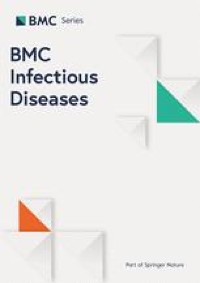Secondary infection in COVID-19 critically ill patients: a retrospective single-center evaluation - BMC Infectious Diseases - BMC Infectious Diseases

In this observational cohort study, we observed a very high incidence of 68% of secondary infections in critically ill patients infected with SARS-CoV-2. Secondary pneumonia (65%) was the most frequently diagnosed secondary infection, followed by bloodstream infection of unknown origin (30%) and catheter-related sepsis (15%). This study suggests that patients suffering from secondary infections may be at higher risk of longer ICU and hospital stay but not of ICU death.
Our results on the high incidence of secondary pneumonia are congruent with other cohort studies investigating secondary pneumonia in critically ill patients infected with SARS-CoV-2 [11]. Remarkably, the observed incidence is threefold higher than the incidence of secondary pneumonia in critically ill patients not infected with SARS-CoV-2 (13.5–23%) [12]. Other respiratory viral infections, such as seasonal/pandemic influenza, Middle East respiratory syndrome coronavirus and SARS-CoV-1 are also characterized by a high incidence of secondary pneumonia [13,14,15]. Bacterial infections responsible for secondary pneumonia originate from co-pathogens that can be found in the respiratory tract. In literature, it has been suggested that this type of pneumonia in critically ill patients may aggravate severity of illness and increases the risk of death [13,14,15,16,17]. In this study however, we couldn't detect an increased risk of death in patients suffering from a secondary bacterial infection. It can be deduced from Table 2 that patients with a DNI code had a large impact on ICU mortality and other outcome variables. This impact most likely explains why we couldn't detect an association between ICU mortality and acquisition of a secondary infection.
In this study cohort the most common type of pathogens responsible for secondary pneumonia were the Gram-negative bacilli, followed by Gram-positive cocci. This observation is consistent with what we would expect based on literature. A large multicenter study, performed in 36 European ICUs, identified Gram-negative bacilli, mainly Pseudomonas auruginosa, Enterobacter species, and Escherichia coli as the most common bacteria involved in secondary pneumonia in COVID-19 patients [5].
Besides secondary bacterial pneumonia, patients with a viral pneumonia in general, are prone for the development of invasive pulmonary aspergillosis, which has a negative impact on duration of hospitalization and mortality [18]. There is some data available, that suggest that critically ill COVID-19 patients have an even higher risk to develop invasive aspergillosis [19]. In this study cohort, the incidence of invasive aspergillosis in patients with a secondary pneumonia was 19.7%. This is in line with other European studies, which report a rate of 20–35% for invasive aspergillosis in critically ill COVID-19 patients with a secondary pneumonia [20, 21].
The incidence of blood stream infection and catheter-related sepsis was comparable with the incidence of secondary infection in critically ill patients not infected with SARS-CoV-2 [22]. The most common pathogens identified in blood cultures or catheter cultures from patients with a bloodstream infection or catheter-related sepsis were Gram-positive cocci. This is in line with the fact that Staphylococcus aureus is frequent a commensal on the skin and often responsible for blood stream infections and catheter-related infections.
The only identified risk factors associated with the acquisition of a secondary infection were a history of diabetes mellitus, the cumulative dose of corticosteroids administered in the ICU, and male gender. However, the investigated cohort was relatively small, thus it is presumable that other risk factors associated with the acquisition of a secondary infection could not be detected. The first identified risk factor, diabetes mellitus, is known to increase the incidence and severity of infectious diseases. Previous research indicates that diabetic patients with COVID-19 admitted to an ICU also have a higher reported mortality than non-diabetic patients [23]. The second factor that was identified as a possible risk factor was the total cumulative dose of corticosteroids administered in the ICU. This is logical, as corticosteroids are a known suppressor of the immune system. However, because of lack of information on timing, no firm conclusions can be drawn on the temporal association between corticosteroid therapy and secondary infection. Routine administration of corticosteroids was not part of the Jessa protocol at the early stage of this study period and were only administrated according to clinical decision of the attending intensivist.
Common policy was to only start corticoids in patients with signs of refractory systemic inflammatory disease without diagnosed secondary infection. Thus, it cannot be ruled out that a third bystander, i.e. more severe COVID-19 disease or pre-existing comorbidities, may have independently increased both cumulative dose of corticoid therapy and risk of secondary infection. Nevertheless, current guidelines advise the administration of corticosteroids to COVID-19 patients treated in the ICU [24]. Apparently, any possible risk associated with the administration of corticosteroids is outweighed by its positive effect on the course of the infectious disease itself. Male gender was also associated with increased risk of secondary bacterial infection. Obviously, this association might also be elicited by a third bystander.
This study has several limitations. First, the retrospective single-center design and the small number of patients included in this cohort negatively impacts the generalizability of our findings. Second, due to the small sample, only univariable analyses could be performed. To confirm the described possible associations further research is necessary. Third, information on identification of bacteria on a species level was not always provided by the department of microbiology. Therefore, we chose to present only broad categories of bacteria (Gram-positive/negative bacilli/cocci).
Comments
Post a Comment